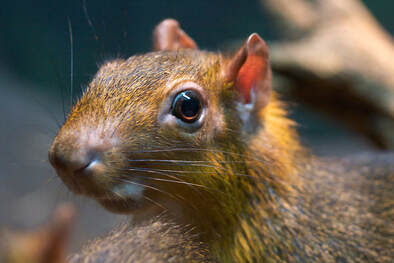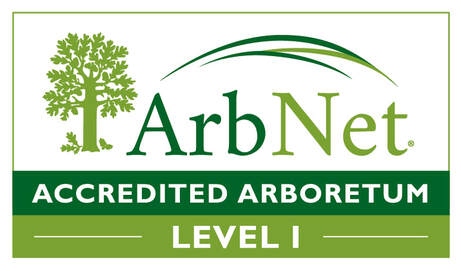Red-Rumped Agouti (Dasyprocta leporina)

Common Name: Red-Rumped Agouti
Scientific Name: Dasyprocta leporina
Physical Description: Red-Rumped Agoutis are rodents that grow to about two feet long. They weigh five pounds on average. Their ears are small and somewhat square, and they have excellent hearing. The Red-Rumped Agouti has short, coarse fur that is brown or black with a yellow or white underbelly. Their name comes from the fact that the red tinted fur on their hindquarters.
They have small tails that range from 1/3 of an inch to 1 1/3 inches. Their front feet have four toes on each foot and their back feet have three toes on each foot. They are diurnal mammals, but they have adapted to become nocturnal in places where they are hunted for food. The Red-Rumped Agouti can jump up to 6 feet straight up!
They have a range of vocalizations including an alarm bark that sounds similar to a small dog barking.
Habitat: They typically live in rainforests but can also be found in other types of forests with dense brush. Red-Rumped Agoutis like to live near water. They are excellent swimmers. They dig burrows along riverbanks, among limestone boulders and under tree roots. They maintain several sleeping burrows in hollow logs, under trees or under dense vegetation and they leave well-defined paths to the burrows.
Range: Although originally native to Brazil, they can be found in the wild from southern Mexico to southern South American including the islands of Trinidad and Tobago.
Diet: Red-Rumped Agoutis are herbivores who eat fruits, nuts, succulent plants, and vegetables.
Lifespan: They live on average 15 years in the wild and up to 20 years in human care.
Social Structure: A male and female Red-Rumped agouti will mate for life. The male is very aggressive toward other males. Females will give birth to one, two or three babies in a litter. Newborn Red-Rumped Agoutis are precocial which means they are born in an advanced stage of development and can feed themselves almost immediately. They are born fully furred, eyes open and they can run within an hour of being born. Although they can feed themselves, they will also nurse for up to 20 weeks.
Status: Least Concern1
Other: The Red-Rumped Agouti is also called Golden-Rumped Agouti, Orange-Rumped Agouti or Brazilian Agouti. Red-Rumped Agoutis are the only mammal species within their native range known to be able to open a Brazil nut husk. By doing so they make a significant contribution to the forestation of their natural habitat.
1 https://www.iucnredlist.org/species/89497102/22197762
Scientific Name: Dasyprocta leporina
Physical Description: Red-Rumped Agoutis are rodents that grow to about two feet long. They weigh five pounds on average. Their ears are small and somewhat square, and they have excellent hearing. The Red-Rumped Agouti has short, coarse fur that is brown or black with a yellow or white underbelly. Their name comes from the fact that the red tinted fur on their hindquarters.
They have small tails that range from 1/3 of an inch to 1 1/3 inches. Their front feet have four toes on each foot and their back feet have three toes on each foot. They are diurnal mammals, but they have adapted to become nocturnal in places where they are hunted for food. The Red-Rumped Agouti can jump up to 6 feet straight up!
They have a range of vocalizations including an alarm bark that sounds similar to a small dog barking.
Habitat: They typically live in rainforests but can also be found in other types of forests with dense brush. Red-Rumped Agoutis like to live near water. They are excellent swimmers. They dig burrows along riverbanks, among limestone boulders and under tree roots. They maintain several sleeping burrows in hollow logs, under trees or under dense vegetation and they leave well-defined paths to the burrows.
Range: Although originally native to Brazil, they can be found in the wild from southern Mexico to southern South American including the islands of Trinidad and Tobago.
Diet: Red-Rumped Agoutis are herbivores who eat fruits, nuts, succulent plants, and vegetables.
Lifespan: They live on average 15 years in the wild and up to 20 years in human care.
Social Structure: A male and female Red-Rumped agouti will mate for life. The male is very aggressive toward other males. Females will give birth to one, two or three babies in a litter. Newborn Red-Rumped Agoutis are precocial which means they are born in an advanced stage of development and can feed themselves almost immediately. They are born fully furred, eyes open and they can run within an hour of being born. Although they can feed themselves, they will also nurse for up to 20 weeks.
Status: Least Concern1
Other: The Red-Rumped Agouti is also called Golden-Rumped Agouti, Orange-Rumped Agouti or Brazilian Agouti. Red-Rumped Agoutis are the only mammal species within their native range known to be able to open a Brazil nut husk. By doing so they make a significant contribution to the forestation of their natural habitat.
1 https://www.iucnredlist.org/species/89497102/22197762






